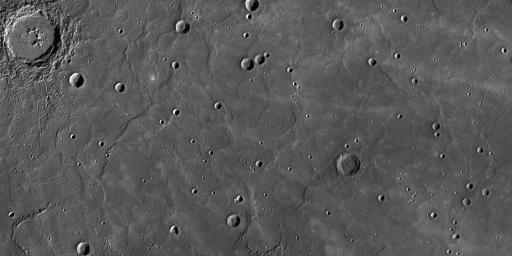This image is a portion of the MDIS global mosaic basemap that was acquired during MESSENGER's first year in orbit. The scene shows a region of smooth, volcanic plains that have been heavily modified by tectonic structures termed "wrinkle ridges". Occurring on the Moon and Mars as well as on Mercury, wrinkle ridges are low, sinuous features that form when lavas cool and subside, causing the crust to contract horizontally. These landforms are often concentrated around buried crater rims, forming circular wrinkle ridges like those in the center right of the image.
While the innermost planet hosts thousands of wrinkle ridges, they are largely confined to its smooth plains, and are morphologically different to the larger, longer faults that comprise Mercury's fold-and-thrust belts. By studying how the different types of tectonic features are distributed across Mercury, MESSENGER scientists can begin to document in detail how the planet has deformed through time.
Date Created: February 10, 2012
Instrument: Mercury Dual Imaging System (MDIS)
Latitude Range: 49.6° N to 60.9° N
Longitude Range: 16.5° E to 48.5° E
Resolution: 400 meters/pixel
Scale: Hokusai, the large, fresh impact crater at top left, is 90 km (56 mi.) in diameter.
Projection: Azimuthal equidistant
The MESSENGER spacecraft is the first ever to orbit the planet Mercury, and the spacecraft's seven scientific instruments and radio science investigation are unraveling the history and evolution of the Solar System's innermost planet. Visit the Why Mercury? section of this website to learn more about the key science questions that the MESSENGER mission is addressing. During the one-year primary mission, MDIS acquired 88,746 images and extensive other data sets. MESSENGER is now in a year-long extended mission, during which plans call for the acquisition of more than 80,000 additional images to support MESSENGER's science goals.
These images are from MESSENGER, a NASA Discovery mission to conduct the first orbital study of the innermost planet, Mercury. For information regarding the use of images, see the MESSENGER image use policy.

 Planetary Data System
Planetary Data System












